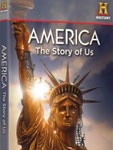America: The Story of US
Question

I have been watching The History Channel, America: The Story of US. I have read the comments from other readers. Some believe that it is a good video for use in the classroom, others say that it is full of misinformation. I would like to have an opinion from a master teacher. What do you think about this video series? Is the information factual or full of misinformation?
Answer
America: The Story of US is a 12-hour, six-part survey by cable channel History, formerly known as The History Channel. The most watched and highest rated program in the network's history, the series is also going to be sent free of charge to every school in the country. So how historically accurate is the program, and how useful is it for the classroom?
As Dr. Jeremy Stern writes for History News Network, the answer is: not enough. "History’s much-touted event is, in reality," he writes, "a shallow and fragmentary jumble." Dramatic moments are "ripped from any larger historical context or explanation in a welter of reenactments and frenzied CGI animation, while celebrity talking-heads [. . .] spout feel-good banalities and populist clichés." Leaning towards "unquestioningly laudatory and simplistic patriotism," the series is not likely to offend.
One way to do this is by thinking of it as another secondary account, similar to a textbook. You might employ the technique of "opening up the textbook." Even though the series is a TV production, the same techniques apply. In the "Superpower" episode, for instance, the series, tells the story of the creation of the interstate highway. As one commentator notes, "the car was your ticket to personal freedom." Such an excerpt might be paired with documents for students to analyze. Did all Americans feel positively about the interstate highway system? Who was in favor of it? Who was against it? When was each source produced and for what purpose? How does this influence the story they tell? After comparing the video excerpt with additional sources, ask students to synthesize the information and make a claim that can be supported by the evidence.
Another way the series might be used in the classroom is as an "authority" to challenge. The technique of "questioning textbook authority", like the technique of opening up the textbook, works equally well with
a video source. For this exercise, you might show students a clip from the "Millennium" episode focusing on Vietnam War protests. Start by giving students sources on the topic. Then, after students have digested them, show them the clip and ask them to critique it. What does the video get right? What does it get wrong? What is included? What is left out? Which claims are supported and which ones aren't?
Alternatively, have them analyze a short clip closely. Ask students to identify the argument or viewpoint represented by the clip and how it conveys that argument. Have students consider features such as word choice, camera angles, soundtrack, and sequencing of images to uncover how the clip conveys its message. Ask students whose voices and perspectives are missing from the clip.
We haven't watched the whole series, and it's too long to show students in it's entirety. But America: The Story of US can potentially be used in a number of productive ways in the classroom; just remember that it's a source like any other and that students should be encouraged to question, examine, and evaluate it.
